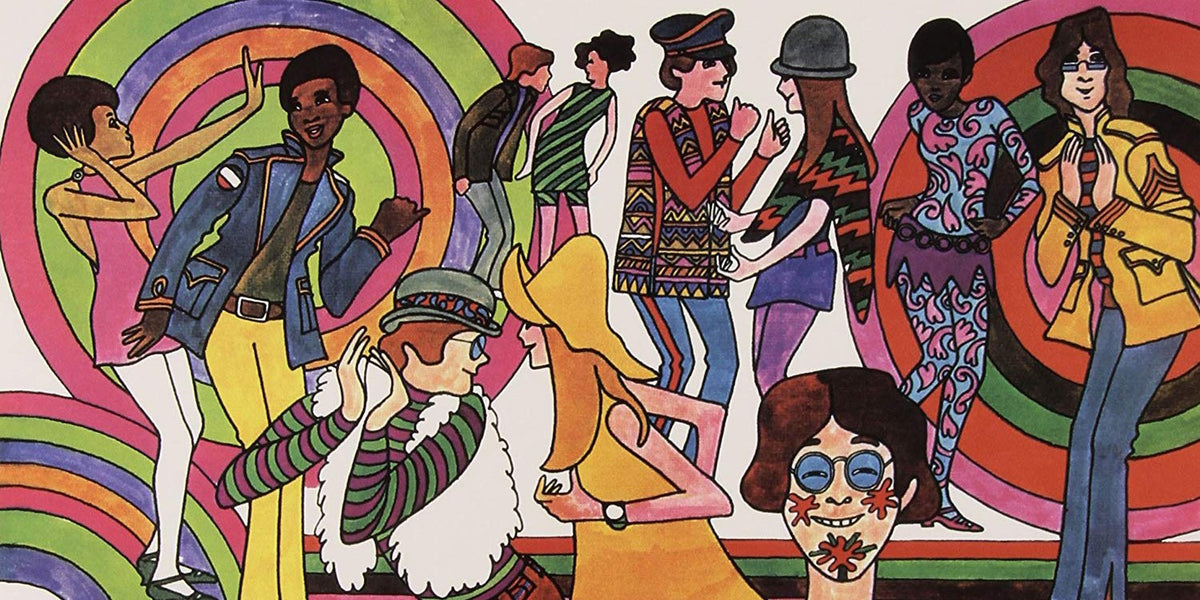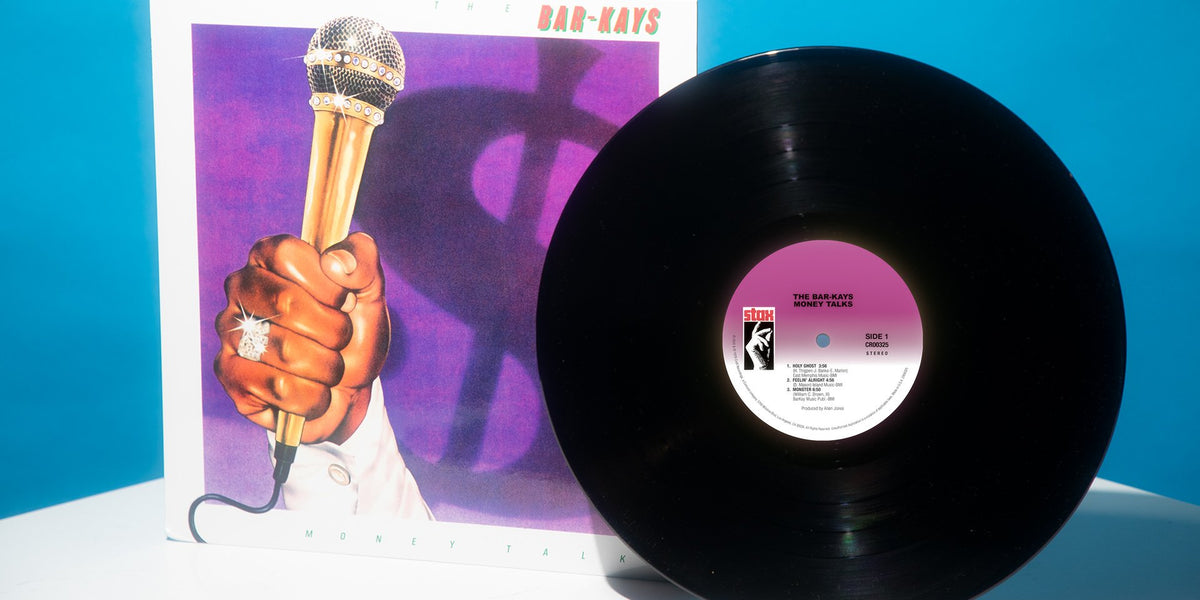The Bar-Kays Album From The Lost Days Of Stax Records
Read An Excerpt From Our Liner Notes For ‘Money Talks’
For the purposes of these liner notes, I’m going to assume that you are familiar with the broad contours of the Stax Records story, thanks to our eight previous Stax Classics selections (I’m including The Immortal Otis Redding here) and likely our The Story Of Stax Records Anthology box set from earlier this year. But as a refresher: Stax Records started life as a small regional soul label, got distributed by Atlantic for a few glory years, realized their contract with Atlantic left them not owning their masters, left Atlantic, and struggled for years to regain their foothold, ultimately culminating in some of the most iconic R&B of the ’60s and ’70s. They had shining towers of success, followed by devastating lows that included the label being forced to close up shop in 1975, when a variety of banking concerns cut them off. By the end, Stax Records couldn’t get into stores or off pressing plant floors, and the label was purchased out of bankruptcy in the late-’70s. Stax was mostly a reissue concern until 2005, when Concord Records bought it, and signed some of the label’s original artists and new artists like Nathaniel Rateliff. Its legacy as the most important soul label ever is undebatable, and assured for history, despite it lasting for roughly 15 glory years.
But there’s a forgotten period in Stax history that brings us here today: the roughly 18 months in 1977 and 1978, when one of the label’s ace songwriters ran a newly relaunched Stax, pulled old songs out of the vault and made new albums, signed new acts and had charting singles. This period was short, and it hardly ranks in any Stax history: Robert Gordon’s veritable Stax bible Respect Yourself: Stax Records and the Soul Explosion devotes only two sentences to this period in its 350+ pages, and Rob Bowman’s earlier Soulsville, U.S.A. devotes a single paragraph. But the music released in this period is some of the best funk and R&B released in the late-’70s, as worthy of rediscovery as much as earlier LPs by label stalwarts. Especially the album that this booklet accompanies: The Bar-Kays’ mammoth Money Talks.
“When Stax closed, they needed to figure out what the assets were in the Stax catalog; they didn’t go to Steve Cropper or Isaac or whoever, they came to me because I was handling A&R when it closed,” David Porter told me in late 2019, from behind a large table in the main studio at his Made in Memphis compound, a new studio and A&R facility in Memphis that Porter runs today. Porter’s A&R duties in the last days of Stax came with a proven track record: he wrote and produced, with Isaac Hayes, Sam & Dave’s iconic Stax albums, and recorded four solo LP’s in the early ’70s, themselves underrated classics, in addition to producing, writing and A&R’ing a variety of Stax projects in between. “I put together the original presentation of the music that was put into the marketplace to shop for sale for the Stax catalog. That was the first step. The next step was after Stax was bought by Fantasy Records. They came to me, because they knew that I knew everything that was in the vault, but they also knew that I had a lot of producing abilities with the artists. So they asked me if I’d be amenable to running the re-launched Stax Records, and would I move to Berkeley, California, to do it. I was definitely interested, but I’m not moving out of Tennessee, so after a while on their part, they decided to have me open an operation. I re-launched Stax under Fantasy. If you Google the records that came out in ’77 and ’78, you’re going to see that there were five or six national charting hit records, out of the catalog I put together. It was a success story starting right away.”
Porter is not wrong; ’77 and ’78 had hits from Shirley Brown, the Emotions, and the Soul Children, and had an Albert King album (1977’s The Pinch) that deserves to be in the discussion of his catalog more than it is (his cover of Ann Peebles’ “I Can’t Stand the Rain” is sublime). But there was no hit bigger on the new Stax than “Holy Ghost,” a song by the Bar-Kays that hit No. 9 on the Soul charts in 1978. Money Talks, the album containing “Holy Ghost,” would go to No. 21 on the Soul Album charts. The song was such a big hit that, while signed to an entirely different record label — the band jumped to Mercury right after Stax closed and became global superstars on a previously inconceivable level — the Bar-Kays performed it on Soul Train. Yet Money Talks feels lost to the dustbins of history, even with its pedigree, and its trivia-worthy existence. “Holy Ghost” was scheduled to be the literal last single released on Stax in 1975; it was scheduled to come out in November, and unfortunately, never actually made it out, as Stax ran out of money to properly press and promote the single¹.
But that lost classic status is definitely not the record’s fault.
The Bar-Kays that emerged in the disco-era late ’70s were not the same Bar-Kays that played “Soul Finger” and backed up Stax stars on the road in 1967. The Bar-Kays’ history is in three distinct parts, cleaved first by tragedy, then by a label closure. The first version of the Bar-Kays was a group of high school kids, who were pests around the Stax studios on 926 E. McLemore Ave., begging to play on records, and often hopping onto vacant studio seats and playing when the M.G.’s went out for smoke breaks. They took their name from a decaying Bacardi billboard, and famously auditioned for M.G. and Stax producer Steve Cropper multiple times with him passing, saying they weren’t ready to be stars. When label founder Jim Stewart heard them playing a groove after being turned down again, he ran up to the controls, hit record, and “Soul Finger” became a huge national hit, after staff producer David Porter plied some neighborhood kids with free Cokes to have them yell the song’s title as the track’s opening party.
The mostly 18-year-old Bar-Kays (James Alexander was a year younger than his bandmates) were becoming stars in their own right, but then became an even bigger deal a few weeks after “Soul Finger” was recorded when Otis Redding heard them playing a club date, and decided that they needed to be his road band. The band wanted to drop out of high school, but their parents refused, so they waited until the night of their high school graduation before flying to the Apollo in New York to go on tour with Redding. They’d be his road band for most of 1967, until flying out on a string of club dates in the Midwest in December that year that would end in tragedy.
The plane crash that killed Otis Redding and four of the six Bar-Kays (trumpeter Ben Cauley survived the crash because he was sleeping holding a seat cushion, and James Alexander survived because it was his turn to fly commercial) altered the plans for the Bar-Kays; they were primed to become the label’s house band, as the M.G.’s were getting burned out, as it became unsustainable to expect them to record every song on every album coming out of Stax. But the Bar-Kays had made a pact, James Alexander told me in 2019, that no matter what happened to any of them, they’d keep making music.
So the Bar-Kays reformed, released the comeback album Gotta Groove in 1969, and eventually did become the new Stax house band, playing on many of the label’s late-’60s and early ’70s smashes; more or less every Isaac Hayes record, and most Albert King records featured the Bar-Kays as the backing band. Cauley left the band in 1971 before they became a big hit again — Alexander says he “carried” the plane crash differently than he did, since he was involved in it, and decided to spend more time at home with his family instead of being in the band; he died in 2015 — after they backed Hayes up on Shaft, and hit the top 10 with their own “Son of Shaft.” It was around this time that the Bar-Kays morphed from a vocal-less instrumental house band to a roaring outfit thanks to the addition of vocalist Larry Dodson. The Bar-Kays envisioned themselves as makers of “black rock,” what they called the forerunner to funk music that they were playing in the studio, a blending of rock, soul, the blues, and heavy grooves, all delivered with excellence and opulence. They started making incredible funk covers as part of their live set, and started pushing their music forward in a way that wasn’t always the norm at Stax; they were sonically adventurous, boundary pushing, and, hard, cool motherfuckers laying down grooves. Their early ’70s output deserves critical reappraisal as spiritual kin to Sly Stone and the Isley Brothers; you need to get yourself to copies of Black Rock, Do You See What I See?, and Cold-Blooded post-haste.
In 1975, the Bar-Kays were gearing up for what would be their sixth Stax LP, and laid down one of their juiciest songs ever: “Holy Ghost,” a song so nice, it’d eventually be on Money Talks twice. It’s got a muscular bassline that could piledrive Jerry Lawler, a drumline breakdown that sounds like the entire Memphis University drum corps playing on the bones of their enemies, and lyrics that play with being born again via a lover’s, well, lovemaking abilities. In fewer words: It’s a literally perfect Bar-Kays song. It was scheduled to be released as a single in November 1975, but as I mentioned earlier, it’s doubtful that ever actually happened: By Christmas, the label was closed and on the auction block. By then, as described in Respect Yourself, most of Stax’s promotions and sales people never knew if any Stax product was making it to shelves.
When Stax closed in 1975, the Bar-Kays were free agents, and signed quickly to Mercury Records, which would be the home for other Stax exiles as well (William Bell chief among them, as he too had his biggest chart success there). Mercury put the Bar-Kays into the studio right away, and they delivered instantly: 1976’s Too Hot to Stop would launch the hit singles “Shake Your Rump to the Funk” and the title track, which would go onto inter-generational infamy as the song that opens 2007’s Superbad. Their 1977 album Flying High on Your Love would be an even bigger hit, making them into one of the premiere funk attractions in music. Which is why it’s understandable that Porter, who in 1977 was hired to relaunch Stax, would hit upon the idea of looking in the Stax vault for any Bar-Kays songs he could find. He didn’t have to look far, since he was A&R’ing for the label when they made “Holy Ghost.”
Porter eventually filled out 1978’s Money Talks with tracks recorded in 1975, between 1974’s Cold-Blooded and when the label closed. That included the original “Holy Ghost” as the album’s first track, and a blown-out longer version called “Holy Ghost (Reborn)” that is two-minutes longer than the original and has crazier vocals; it starts with a church-like call to arms, and features a lot more group vocals on the choruses. It also has a gnarly synth breakdown that’s hard to imagine on any Stax album, 1978 or otherwise. You might think it’s weird, or short shrift to have the same song on an album twice, but really, the versions offer such divergent images of the Bar-Kays that it’s as much of a showcase for their dexterity as three or four different songs by themselves.
The other four songs on the Money Talks are powerhouses in their own way. The cover of “Feelin’ Alright” is like if you held a funk-house mirror up to Joe Cocker’s well-known version, and had the Memphis horns as the backing chorus. Their cover of Grand Funk Railroad’s “Mean Mistreater” is a noir-funk classic, and “Monster” is a return to their instrumental funk roots. The title track is another slab of funk, the Bar-Kays’ answer to “what this needs is more cowbell.” Six songs, 35 minutes, all killer, no filler.
As Porter mentioned up top, the album was a hit: It went to No. 21 on the album charts. The group played Soul Train in support of it, and it helped propel them to even higher heights because it kept them fresh without having to make a new album; their catalog was robust, and Bar-Kays fans didn’t have to wait long for new albums. They’d have bigger hit albums throughout the late ’70s and into the ’80s, and Alexander is still touring, celebrating the band’s 55th anniversary in 2019.
There would be only a handful more new Stax LP’s (Sho Nuff’s From the Gut to the Butt is as wild as its title), as Porter ultimately quit the label in 1979 when the president of Fantasy at the time told Porter he wasn’t interested in running a new record company. He wanted him to decide which albums to reissue and keep making money off the old catalog, which Porter wasn’t as interested in. “My spirits dropped, and shortly thereafter, I left Stax,” he told me. “They didn’t want to have the drama with a new label, they wanted me to work the catalog only. It was really disheartening to me, since we had had such success with the new albums.” Fantasy went back to reissuing the catalog, keeping Stax present in the collections of music fans ever since, a true public service if there ever was one.
Porter has the original fingersnap sign logo from the Stax studio in the basement of Made in Memphis, a trophy of the years he spent toiling in the theater on E. McLemore, willing musical masterpieces into existence. He’s not going to be remembered for his time running Stax in the late ’70s, or how he made this incredibly fun, endlessly replayable Bar-Kays album out of studio scraps, but when I’m listening to Money Talks for the 40th or 400th time, it’s hard to not to think maybe he should be.
¹ That’s according to the official records available in the Fantasy archives at the Stax Museum, which I looked at in January 2020. Some sources say it actually did come out, but no copies have made it to secondary marketplaces. I can’t imagine David Porter wanting to release something that had already been out, either.
Andrew Winistorfer is Senior Director of Music and Editorial at Vinyl Me, Please, and a writer and editor of their books, 100 Albums You Need in Your Collection and The Best Record Stores in the United States. He’s written Listening Notes for more than 30 VMP releases, co-produced multiple VMP Anthologies, and executive produced the VMP Anthologies The Story of Vanguard, The Story of Willie Nelson, Miles Davis: The Electric Years and The Story of Waylon Jennings. He lives in Saint Paul, Minnesota.
Related Articles
Join the Club!
Join Now, Starting at $36Pages






